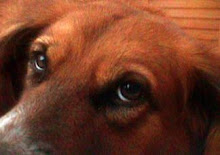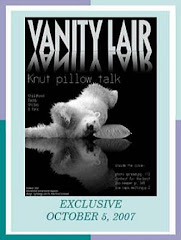 Diesmal beginnen wir mit den guten Nachrichten...Nein, der Klapperstorch flog nicht nach Berlin, sondern nach Toledo...Und zwar schon am 3.Dezember gab es dort Nachwuchs für die 11jährige Crystal, die dort 2 Junge zur Welt brachte von denen eines bislang überlebt hat. Der Tod des anderen Jungtieres ist vermutlich durch ein Problem mit der Nabelschnur verursacht worden.
Diesmal beginnen wir mit den guten Nachrichten...Nein, der Klapperstorch flog nicht nach Berlin, sondern nach Toledo...Und zwar schon am 3.Dezember gab es dort Nachwuchs für die 11jährige Crystal, die dort 2 Junge zur Welt brachte von denen eines bislang überlebt hat. Der Tod des anderen Jungtieres ist vermutlich durch ein Problem mit der Nabelschnur verursacht worden.Crystal ist bereits Mutter von Twins, die 2006 zur Welt kamen, Anana und Aurora, über die wir in den K-files auch schon berichtet haben.Vater ist der 13 jährige Marty.

TOLEDO -- The Toledo Zoo is pleased to announce the birth of a polar bear cub on Thursday, December 3. Eleven-year-old mother Crystal is caring for the cub in a den area off-exhibit, and the Zoo’s animal care staff is continuously monitoring the cub’s progress. The cub was one of two born that day; the other cub only survived for a few days.
Polar bears care for their young in the seclusion of their dens, and animal care staff has been monitoring Crystal and the cub’s progress remotely on video camera. According to the Zoo’s veterinary staff an umbilical problem appears to be reason that the other cub did not survive.
Zoo officials have good reason to be cautiously optimistic about the future well-being of the surviving cub. In November 2006, Crystal gave birth to twins Anana and Aurora and the Zoo is hopeful that she will demonstrate the same excellent maternal behaviors as a second-time mother that she did throughout her previous experience. Thirteen-year-old father Marty can be seen in the Arctic Encounter® exhibit, and if the cub’s rearing goes well, he or she may also be on exhibit in the spring.
The Zoo’s Curator of Mammals, Dr. Randi Meyerson, is the coordinator for the polar bear Species Survival Plan (SSP), established by the Association of Zoos and Aquariums. According to her, there have been very few successful polar bear births in the past five years, and that cub mortality in zoo environments is approximately 50%. In certain wild populations cub mortality has risen to around 63%. The breeding of Crystal and Marty was recommended by the SSP to ensure a healthy zoo population.
Because of the probable impact that climate change will have for Arctic populations, polar bears are protected under the Endangered Species Act, and this underscores the need for preservation of the species through the SSP. As Dr. Anne Baker, The Toledo Zoo’s Executive Director, states, “As the number of polar bears in the wild decreases, it’s more important than ever that cubs in zoo settings serve as ambassadors for their counterparts in the wild. Truly, every cub counts, and we hope that this cub will have the chance to inspire our visitors to join us in caring for polar bears and their environment.”
Source: Toledo on the move/05.01.2010, Foxtoledo/similar article with photos
Related:Anana & Aurora in the K-files
More good news from St.Petersburg: Twins for Leningrad Zoo
The polar bear cubs were born in late November, but by tradition the zoo has not been in a hurry to report the news. Which sex the babies have, is unclear.This will be known, probably only in spring, when the mother herself will lead them out of the den. There are surveillance cameras installed in the den. Employees of the zoo are watching with delight Uslada, the mother and her babies.
Uslada is a real mother-heroine. If counted correctly, Uslada must have given birth to fifteen cubs in total. Her previous offspring is scattered around the world. Uslada has been living in St. Petersburg since 1993. And her husband, a favorite of the public Menshikov since 1989. Menshikov was caught then together with his mother and his brother under dramatic circumstances at Kap Menshikov in the north west of Russia. They had been approaching frequently the settlement Amderma and "stolen" food of the military basis there.His brother suffered of an old injury, a big hole close to his nose causing respiratory trouble, was treated by plastic surgery, he didn't survive. Menshikov is described as a very picky bear ...Uslada is one of three females he had been mating with. The last time Uslada gave birth two years ago. Peter and Krasin (see photo). Peter was sent to Japan, Krasin to Novosibirsk.
 Uslada with Pjotr and Krassin in March 2008
Uslada with Pjotr and Krassin in March 2008"Die Mutter heißt Uslada, sie wurde am 19. November 1987 in Kazan geboren und lebt seit 1993 in Sankt Petersburg. Der Vater Menshikov, er wurde am Kap Menshikov im Nordwesten Russlands in einer dramatischen Aktion im September 1989 zusammen mit seiner Mutter Amderma und einem Bruder eingefangen, weil sie sich immer wieder der Siedlung Amderma genähert hatten und in das Nahrungsmittellager der dortigen Militärbasis „eingebrochen“ waren. Sein Bruder hatte eine große Wunde im Gesicht die von einem Plastischen Chirurgen behandelt wurde. Er hatte ein großes Loch an der Nase, das ihm das Schlucken und Atmen erschwerte, eine alte Verletzung. Leider hat er es trotzdem nicht geschafft.
 Uslada teaching how to fish...
Uslada teaching how to fish...Menshikov und Uslada haben schon ein paar Mal erfolgreich Nachwuchs produziert. Und hier kommt UlliJ:
"Sie hat in der Tat 15 Jungtiere geboren, allerdings sind da zweimal Drillinge darunter. 1996 hat sie 1 Jungtier geboren, das überlebt hat, Syril (männlich), der lebt jetzt in Guangzhou in China.
1998 hat sie 2 Jungtiere geboren, wir wissen nicht genau, ob beide Tiere überlebt haben. Nummer 1 heißt Cora (weiblich) das ist die Cora aus Brno. Von ihrem Bruder wissen wir den Namen nicht, vermuten aber dass er auch in Guangzhou gelandet ist.2000 hat sie 2 Jungtiere geboren, beide haben überlebt. Lutik (männlich) lebt im Alaska Zoo in Anchorage und Lia (weiblich) lebt in Sea World Gold Coast in Australien. 2002 hat sie Drillinge bekommen, alle haben überlebt, Bering (männlich) lebt in Laohutan Ocean Park in Dalian in China und Malygin (weiblich) lebt auch da und Sedov (männlich) ...2004 hat sie Drillinge bekommen, nur eins hat überlebt. Kai (männlich) lebt in Sendai, Japan. 2007 hat sie 2 Jungtiere bekommen, zwei Männchen, Krassin lebt in Nowosibirsk (seit 2008) und Pjotr im Zoo Shizuoka, Japan."
Source: here/russ., google transl/engl. and UlliJ Related: Commander Sedov in the K-files/October 2009 & World of Animals-Forum/Ulli Spenke And more wonderful photos of Uslada teaching Pjotr & Krassin how to fish, you will find here

Traurige Nachrichten allerdings aus dem Zoo in Ranua/Finnland
Eisbärin Venus bekam am 15.12. zwei Babys. Das erste starb gleich oder war schon bei der Geburt tot. Das Zweite pflegte Venus mit grosser Liebe. Alles schien gut zu laufen. Doch etwas passierte am 21.12., Venus wollte sich nicht mehr um ihr Baby kümmern. Es lebte noch, machte aber keine Geräusche und bewegte sich langsam. Tierpfleger und der Tierarzt versuchten das Baby zu retten, aber zu spät.
Es ist noch unklar, warum die Babys starben. Für die mit knapp 5 Jahren noch sehr junge Venus war es die erste Schwangerschaft.
 We all remember the first pics when love was in the air between at that time 19 years old Manasse and 4 years old Venus...They really did it, Venus got pregnant and delivered 2 cubs on 15 December, one cub was probably stillborn. Venus took good care of the second cub which seemed to develop well. But for some unknown reason she redused to be near the cub last Thursday.
We all remember the first pics when love was in the air between at that time 19 years old Manasse and 4 years old Venus...They really did it, Venus got pregnant and delivered 2 cubs on 15 December, one cub was probably stillborn. Venus took good care of the second cub which seemed to develop well. But for some unknown reason she redused to be near the cub last Thursday."The cub didn’t make any noises and moved very slowly. The keepers decided to take the cub from her mother since it looked like she had abandoned the cub. Rapidly the cub was taken to the vet and for a while it looked like it would survive. Sadly the little cub died in the evening.
Both cubs have been sent to EVIRA for autopsy in order to find out the reason for why they didn’t survive."
Source with more related links to Venus & Manasse here on KWMCartoon credits:Klapperstorch by Frau Schnatterliese's genial cartoonist Réné Meier- more here















































Keine Kommentare:
Kommentar veröffentlichen